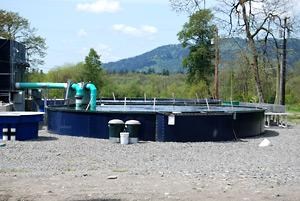City of Powell River officials are continuing to explore the possibility of establishing an aquatic industries park in conjunction with Tla’amin (Sliammon) First Nation.
The proposal centres on about 40 hectares (100 acres) of undeveloped waterfront land owned by PRSC Partnership Ltd. next to Catalyst Paper Corporation’s Powell River division. The site has a number of infrastructure advantages for aquaculture, according to a brochure produced by PRREDS (Powell River Regional Economic Development Society), including both salt and fresh water supplies, electricity and thermal energy.
The city organized an exploratory meeting with potential industry proponents in January.
MP John Weston, who represents West Vancouver-Sunshine Coast-Sea to Sky Country, recently met with Mayor Dave Formosa, councillors Chris McNaughton and Debbie Dee, Tla’amin Chief Clint Williams and chief administrative officer Rod Allan, Mac Fraser, the city’s chief administrative officer, Scott Randolph, PRREDS manager, and Bill Vernon, a Powell River resident who has been consulting on the project.
“We focused on an amazing convergence of events, circumstances and relationships,” Weston said about the meeting. “That’s the possibility of creating a world-class closed containment aquaculture facility here in Powell River.”
The relationship between Tla’amin and the city, the availability of land and a potential source of relatively inexpensive energy from Catalyst’s Powell River division are all positive factors, Weston pointed out. He added that he is a member of the House of Commons’ Standing Committee on Fisheries and Oceans, which recently released a report on closed containment salmon aquaculture. “The report calls for a centre of excellence in this area, it calls for innovation, it calls for environmentally friendly rearing of fish at a time when the world needs more protein,” he said. “All of these things create an incredible opportunity.”
One of the other advantages in Powell River is Vancouver Island University (VIU), Weston said, which already runs the Centre for Shellfish Research and the International Centre for Sturgeon Studies. “If you want to create a centre of excellence, ideally you have some sort of academic component, where you can conduct applied research,” he said. “You get people studying things that can be applied and put into industrial use right there and students who could benefit from the opportunity to actually be involved in a commercial enterprise.”
Weston said his suggestion to the group was to develop a memorandum of understanding (MOU). It would be a general statement of principles, not a detailed statement of purpose, which could be used to attract private sector participants to look at the possibility and help build it. “It can also be used by me to engage with the ministry of fisheries and the ministry of industry, trade and commerce, to see what support might be available from the federal government,” he said.
Formosa said after he read an article about the committee’s report, he requested a meeting with Weston about the city’s project. He wanted to pursue the recommendation to establish a centre of excellence, since Powell River’s proposal has all the elements.
The city is pursuing an MOU among Tla’amin, Catalyst, VIU and School District 47, Formosa said. “Basically, we’re looking at bringing these players together, seeing if they’re interested and then going out to find industry to join us, because that’s key,” he said. “You need industrial players.”
They’re hoping to convince industry representatives to join the project, Formosa added. “If we create a facility and they have an idea for new technology, government may help pay for equipment, tests and trials, as long as they’re done in the context of a centre of excellence,” he said. “We can talk about policies and procedures and help shape the industry that’s coming, in conjunction with the government.”



